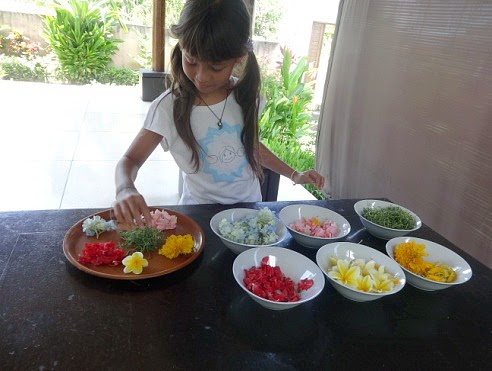
Today we are pleased to share a practical life presentation that demonstrates these ideas in a wonderful activity created by NAMC Lower Elementary student Komang Krisna Arisusanthi. Komang lives in Bali where she works as an assistant in a Montessori school. Her activity, Making a Balinese Daily Offering, describes canang sari, a daily offering made by Balinese people to show thanks for peace given to the world.
Making a Balinese Daily Offering (Canang Sari): Montessori Practical Life, Culture Studies and Peace Education
Purpose
To develop concentration, fine motor skills, and coordination of movement, to refine the sense of order, and to raise cultural awareness by preparing a Balinese offering.
Material

- Two pre-cut coconut palm leaves, 50 cm long, a bowl of bamboo needles, a bowl of banana leaves cut into 9 X 9 cm squares, a ruler, a pencil, and scissors on a tray.
- A small tray.
- Five bowls of different kinds of fresh cut flowers or flower petals (if possible in different colors, sizes, and scents) and one bowl of shredded pandan leaves. The bowls of flowers may be left on the shelf.
- NOTE: Make sure the flowers are safe to use (some children are allergic to pollen) and remove any thorns or sharp parts.

Presentation
This is an individual presentation. The Montessori teacher presents this activity in years 2 and 3.
- Find a suitable location in the environment to work on this activity.
- Familiarize yourself with the presentation and the steps involved.
- Consider the child who will be receiving this presentation and make modifications as required.
- Introduce the activity by naming it and linking the lesson to the child’s prior learning. Children in Bali are aware of the existence and the use of daily offerings as these offerings are found everywhere, including homes, entrances of most buildings, beaches, shops, and other public places.
- Name any materials that are new to the child.
Part 1: Making the Coconut Leaf Box
- Invite the child to the shelf to learn to make a daily offering.
- With the child, carry the tray of material to the work area.
- Demonstrate how to make the box using one 50 cm coconut leaf.
- Measure along one side of the coconut leaf with the ruler and mark every 10 cm using the pencil.
- With the scissors, cut along each marked line to the vein of the leaf.
- Fold the leaf at each cut, making it into a square. Pin the corners in place using the bamboo needles.
- The completed box will be approximately 10 x 10 cm.
- Place a square banana leaf in the box to create the base.
- Invite the child to make a coconut leaf box in the same manner.
Part 2: Decorating the Box
- Invite the child to accompany you to the shelf to choose a selection of flowers.
- Show the child how to fill the small tray with flowers and shredded pandan leaves.
- Model how to carry the tray carefully and close to the body and return to the work area.
- Take flowers from the tray, one at a time, and place them in the box in a clockwise direction, starting at the upper left-hand side of the coconut box.
- Invite the child to do the same, filling her coconut box.
- Place the shredded pandan leaves in the center, on top of the flowers. Ask the child to do the same.
- When the child has finished, she may choose a place to put the offering. These offerings are often used as a table centerpiece.

Part 3: Tidying Up
- When the child has finished the activity, complete the work cycle by demonstrating how to clean up the materials – sweeping up spilled petals and leaves, cleaning the bowls and trays, and placing the material back on the shelf, ready for the next child to use.
As much as possible, NAMC’s web blog reflects the Montessori curriculum as provided in its teacher training programs. We realize and respect that Montessori schools are unique and may vary their schedules and offerings in accordance with the needs of their individual communities. We hope that our readers will find our articles useful and inspiring as a contribution to the global Montessori community.
© North American Montessori Center - originally posted in its entirety at Montessori Teacher Training on Friday, February 28, 2014.
© North American Montessori Center - originally posted in its entirety at Montessori Teacher Training on Friday, February 28, 2014.


0 comments:
Post a Comment
Have questions or comments? Let us know what you thought about this article!
We appreciate feedback and love to discuss with our readers further.